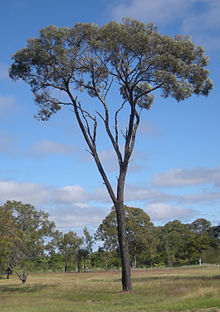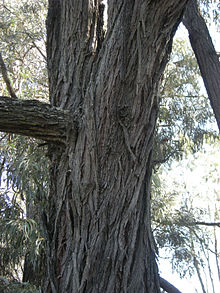- Acacia harpophylla
-
"Brigalow" redirects here. For the town in Australia, see Brigalow, Queensland.
Acacia harpophylla 
Scientific classification Kingdom: Plantae (unranked): Angiosperms (unranked): Eudicots (unranked): Rosids Order: Fabales Family: Fabaceae Genus: Acacia Species: A. harpophylla Binomial name Acacia harpophylla
F.Muell. ex Benth.Acacia harpophylla, commonly known as the Brigalow , Brigalow Spearwood or Orkor is an endemic tree of Australia. It is found in central and coastal Queensland to northern New South Wales. It can reach up to 25 meters tall and forms extensive open-forest communities on clay soils.
Two species, brigalow (A. harpophylla) and gidgee (A. cambagei) form open woodlands on flat and gently undulating terrain on heavy and relatively fertile clay and clay-loam soils primarily in the 300-700mm annual rainfall region of Eastern Australia. These woodlands extend from a northern extreme of 20o S into northern New South Wales. Brigalow and gidgee occur as mixed communities in some regions and are commonly associated with several other woody species, including overstorey species such as Eucalyptus coolabah, E. cambageana, Casuarina cristata, and a range of understorey species.[1][2] Chloris, Paspalidium, Dicanthium, Sporobolus and Eragrostis species.[7]
References
- World Wide Wattle. Acacia harpophylla
Specific references
- ^ Scanlan, J. C. (1988). Managing tree and shrub populations. Native pastures in Queensland their resources and management. W. H. Burrows, J. C. Scanlan and M. T. Rutherford. Queensland, Queensland Government Press.
- ^ a b c Anderson, E. and P. Back (1990). Fire in brigalow lands. Fire in the management of northern Australian pastoral lands. T. C. Grice and S. M. Slatter. St. Lucia, Australia, Tropical Grassland Society of Australia.
- ^ a b c d Johnson, R. W. and W. H. Burrows (1994). Acacia open forest, woodlands and shrublands. Australian Vegetation. R. H. Groves. Cambridge, Cambridge University Press.
- ^ Weston, E. J. (1988). The Queensland Environment. Native pastures in Queensland their resources and management. W. H. Burrows, J. C. Scanlan and M. T. Rutherford. Brisbane, Queensland Government Press.
- ^ Anderson, E. R. (1993). Plants of Central Queensland. Brisbane, Queensland Government Press.
- ^ Flannery, T. (1994). The future eaters. Frenchs Forest, Australia., Reed New Holland.
- ^ Weston, E. J. (1988). Native Pasture Communities. Native pastures in Queensland their resources and management. W. H. Burrows, J. C. Scanlan and M. T. Rutherford. Brisbane, Department of Primary Industries.
Wikimedia Foundation. 2010.


